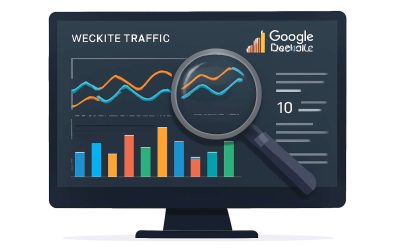Understanding Website Traffic Analysis
Defining Website Traffic Analysis
Understanding website traffic analysis is like unlocking the secret heartbeat of your online presence. It’s not just about counting visitors; it’s about deciphering the story behind each click, each visit, and each interaction. When you delve into website traffic analyse, you gain insights into which pages captivate your audience, how they navigate your site, and where your traffic is genuinely coming from. This knowledge transforms raw numbers into strategic opportunities, guiding you to optimise content, improve user experience, and elevate your SEO game.
For those seeking a comprehensive picture, focusing on key metrics is essential. These include visitor sources, bounce rates, session durations, and conversion pathways. By examining these facets, businesses can make data-driven decisions that align with their growth objectives. Truly, website traffic analyze is the cornerstone of a successful digital strategy, offering clarity in a sea of data and empowering you to shape your online narrative with confidence.
Importance for SEO and Business Growth
Understanding website traffic analyze is like peering into the hidden currents that propel your digital voyage. It reveals the subtle shifts in visitor behaviour, illuminating pathways that might otherwise remain obscured. For SEO and business growth, this knowledge is invaluable — it transforms raw data into a map of opportunities. When you truly grasp the significance of website traffic analyze, you unlock the ability to refine your content, enhance user experience, and craft strategies rooted in real insights.
Imagine discovering which channels funnel the most visitors or identifying pages that hold your audience’s attention the longest. By focusing on these elements, businesses can optimise their efforts and navigate the ever-changing landscape of online competition with confidence. Truly, the magic of website traffic analyze lies in its power to turn numbers into a compelling story of growth and discovery.
Key Metrics to Track
In the labyrinth of digital presence, understanding the key metrics of website traffic analyze can feel like uncovering the hidden heartbeat of your online world. These metrics serve as the compass, guiding you through the intricate dance of visitor behaviour and engagement. When you focus on the right indicators, every click becomes a story—each one revealing what captivates your audience and what falls silent.
Among the essential elements to monitor are visitor numbers, bounce rates, session durations, and conversion rates. These figures, when examined with care, illuminate the pathways that lead your audience deeper into your site’s narrative. To truly master the art of website traffic analyze, consider tracking:
- Source of traffic – where your visitors are coming from
- Engagement levels – how long they stay and what they explore
- Conversion pathways – the journeys that turn visitors into loyal customers
Each metric is a brushstroke in the grand canvas of your digital story, revealing insights that can transform raw data into strategic brilliance. Truly, website traffic analyze isn’t just about numbers—it’s about capturing the elusive pulse of your audience’s desires and behaviours.
Tools and Software for Website Traffic Analysis
Google Analytics
In the labyrinth of digital engagement, tools like Google Analytics serve as the lanterns guiding your voyage through the shadowed corridors of website traffic analyse. With every click and scroll, these sophisticated software offerings unveil the silent stories woven into visitor behaviour, revealing patterns that transform raw data into actionable insight. The mastery of such tools empowers marketers and entrepreneurs alike to decode the mysteries behind visitor origins, engagement levels, and conversion pathways.
Google Analytics stands as a titan among website traffic analyse tools, offering a tapestry of features designed to illuminate the unseen. Its real-time reporting paints a vivid picture of ongoing user activity, while custom dashboards allow for an immersive, personalised understanding of your digital domain. For those seeking an even deeper dive, the platform’s ability to integrate with other software creates a symphony of data points—each contributing to a holistic view of your website’s performance.
In essence, harnessing the power of these tools transforms abstract numbers into a compelling narrative—one that reveals exactly what drives visitors and what keeps them lingering. As the digital landscape evolves, so too does the art of website traffic analyse, shaping the future of SEO with each nuanced insight uncovered.
Other Popular Analytics Tools
When it comes to website traffic analyse, relying solely on Google Analytics is like bringing a knife to a gunfight. Enter other popular analytics tools that diversify your data armoury and give you a sharper edge. These platforms often offer unique features that can reveal hidden layers of visitor behaviour, turning your website into a well-oiled conversion machine.

Take, for example, Hotjar. It’s like having a fly on the wall, offering heatmaps and visitor recordings that make it crystal clear where users are getting cosy and where they’re bouncing out. Meanwhile, SEMrush not only tracks website traffic analyse but also digs into competitors’ data, helping you understand where your rivals are winning the traffic game.
Other notable contenders include Crazy Egg and Mixpanel. These tools excel at providing visual insights and behavioural analytics, respectively, enriching your understanding of how visitors interact with your site. For a quick overview, here’s a taste of what they bring to the table:
- Heatmaps and scroll maps
- Conversion funnel analysis
- Event tracking and user segmentation
With such a smorgasbord of options, your website traffic analyse becomes not just about numbers but about storytelling—crafting a narrative that guides your SEO strategy with a dash of ingenuity and a sprinkle of data-driven magic.
Choosing the Right Tool for Your Needs
Choosing the right tool for your website traffic analyze can feel akin to selecting a fine wine — both require nuance, taste, and a dash of daring. With an array of options, it’s tempting to go for the popular or most flashy, but the trick lies in finding a platform that aligns with your specific needs. Do you crave granular behavioural insights, or is your priority to spy on competitors’ traffic strategies? The spectrum of tools, from heatmaps to advanced event tracking, caters to this varied palette of requirements.
For instance, some platforms excel at visual storytelling, offering heatmaps and scroll maps that reveal where visitors linger or lose interest. Others dive deep into behavioural analytics, segmenting users to uncover hidden patterns of engagement. The key is selecting a tool that complements your SEO ambitions—after all, a well-chosen platform transforms raw data into a compelling narrative that guides your digital strategy.
How to Conduct Effective Website Traffic Analysis
Setting Up Tracking Parameters
In the shadowed corridors of digital analytics, setting up tracking parameters becomes the key to unlocking the secrets hidden within your website traffic analyze. Without precise markers, the vast expanse of data remains a labyrinth, impossible to navigate with clarity. By meticulously configuring URL parameters, utm tags, and event codes, you ensure that every visitor’s journey is etched into the tapestry of your analytics. This process transforms raw numbers into stories that reveal where your visitors originate, what draws them in, and how they traverse your digital domain.
To conduct an effective website traffic analyze, consider creating a structured plan—like a ritual—mapping out the sources and mediums you wish to scrutinise.
- Use consistent naming conventions for campaigns
- Implement tracking codes on all key pages
- Regularly review and refine your parameters
Such diligence transforms data chaos into a symphony of actionable insights, illuminating the unseen forces that shape your online presence.
Analyzing User Behavior Patterns
Effective website traffic analyze is akin to deciphering a complex mosaic—each piece representing a visitor’s choice, behaviour, and journey. When you delve into user behaviour patterns, you uncover subtle cues about what truly engages your audience. It’s not just about numbers but about interpreting the stories behind those numbers. Observing how visitors navigate your site, where they linger, and which pages prompt action reveals invaluable insights—insights that can transform your digital strategy.
To truly harness the power of website traffic analyze, consider implementing a structured approach. For example, tracking specific events such as clicks on call-to-action buttons or video plays can shed light on engagement levels. Using a combination of heatmaps and session recordings offers a vivid tableau of user interactions, capturing moments often missed by traditional metrics. This layered perspective helps identify friction points and opportunities for optimisation.
Remember, consistency is vital. Regularly reviewing your data and refining your tracking setup ensures your insights remain precise and relevant. Whether you are analysing source channels or content performance, a nuanced understanding of user behaviour patterns drives smarter decisions, ultimately elevating your online presence and boosting your SEO efforts. Embrace this meticulous process, and the labyrinth of your website traffic analyze transforms into a corridor of opportunity and growth.
Identifying Traffic Sources
Understanding where your website traffic originates is like uncovering the secret passageways of a hidden city. Effective website traffic analyse begins with identifying traffic sources—those elusive channels that bring visitors to your digital doorstep. By dissecting whether your traffic comes from organic search, paid campaigns, social media, or referral links, you gain a clearer picture of your audience’s behaviour and interests.
Using tools such as Google Analytics, you can set up custom segments to isolate each source. This allows you to see which channels are driving the most engaged visitors and which might need a strategic boost. A simple yet powerful approach involves creating a list of key traffic sources:
- Organic search
- Paid advertising
- Social media platforms
- Referral links
Tracking these sources over time reveals patterns and shifts, turning raw data into actionable insights. When you master the art of website traffic analyse, the maze of digital pathways transforms into a strategic blueprint—guiding your efforts with precision and purpose.
Monitoring Bounce Rates and Engagement
In the shadowed corridors of the digital realm, understanding visitor engagement becomes an obsession—an essential ritual in the art of website traffic analyse. Tracking bounce rates whispers secrets about the allure or repulsion of your content, revealing whether visitors linger or vanish into the abyss. When analysing engagement, one must peer beneath the surface, seeking signs of true interest—time spent, pages viewed, actions taken—that illuminate the heartbeat of your audience.
A labyrinth of data awaits, but focus on these spectral indicators:
- Average session duration
- Pages per session
- Conversion rates
Monitoring these metrics over time exposes patterns that might be missed in the chaos of raw numbers. Every fluctuation, every spike or decline, paints a picture—sometimes haunting, sometimes inspiring—guiding your strategic dark craft. To truly master website traffic analyse, one must become both detective and storyteller, unraveling the mysterious motives behind each visit.
Interpreting Traffic Data for SEO Optimization
Analyzing Organic vs Paid Traffic
Understanding the nuances of website traffic analyse is essential for honing your SEO strategy. When interpreting traffic data, distinguishing between organic and paid traffic reveals where your audience truly engages. Organic traffic, driven by search engine optimisation, often reflects authentic interest—those visitors genuinely seeking your content or products. In contrast, paid traffic results from targeted advertising campaigns, offering immediate visibility but requiring careful evaluation to ensure return on investment.
To truly grasp the impact of each, consider examining metrics like bounce rates, session duration, and conversion paths. This helps uncover whether your organic visitors are more likely to stay and interact, or if paid campaigns are driving quick, fleeting visits. A balanced approach involves continuously analysing these traffic sources, ensuring your website traffic analyse yields insights that fuel sustainable growth and refined marketing efforts.
Keywords and Search Queries
Understanding how visitors arrive on your site is the backbone of effective SEO. When performing a website traffic analyze, pay close attention to search queries and keywords that drive organic traffic. These insights reveal what your audience is actively seeking and can guide content optimisation.
Analyzing traffic data also uncovers patterns in user behaviour. For example, high bounce rates on specific pages might indicate misaligned keywords or irrelevant content. Conversely, longer session durations often signal that your keywords are attracting genuinely interested visitors.
To deepen your understanding, consider categorising search queries into segments such as informational, navigational, or transactional. This segmentation aids in tailoring your SEO strategies, ensuring you focus on keywords that truly matter. Remember, a comprehensive website traffic analyze isn’t just about numbers — it’s about uncovering the intent behind each visit.
Identifying High-Performing Content
Interpreting traffic data is where the real magic of SEO unfolds. When you delve into your website traffic analyze, you uncover hidden patterns that reveal what truly resonates with your visitors. High-performing content often emerges as a beacon—drawing in engaged users who linger longer and interact more. Spotting these pages is crucial, as they serve as the backbone of your organic growth.
To pinpoint these gems, look for content that consistently attracts quality traffic. A careful website traffic analyze can expose which topics or keywords are delivering unexpected success. In some cases, a single piece of content can suddenly skyrocket in ranking, revealing a niche audience eager for your insights. Recognising these signals allows you to amplify your efforts on what works, transforming data into a strategic advantage.
- Identify pages with the highest engagement and conversion rates
- Analyse the search queries that led visitors there
- Assess whether the traffic aligns with your core goals
By honing in on these high-performing pieces, you ensure your SEO strategy remains razor-sharp—focused on content that not only attracts traffic but also cultivates loyalty. Remember, a meticulous website traffic analyze is your secret weapon in deciphering the true potential of your digital presence.
Understanding User Demographics and Devices
Understanding user demographics and devices is a crucial facet of website traffic analyze that often goes unnoticed amidst broader metrics. When you peel back the layers of traffic data, insights about age, location, and interests reveal themselves, painting a vivid picture of your audience’s character. Recognising which devices visitors prefer—be it smartphones, tablets, or desktops—can dramatically influence your optimisation strategies.
A seamless experience across all devices is no longer optional; it’s imperative. For example, if data shows a surge in mobile traffic, prioritising mobile-friendly design can boost engagement and reduce bounce rates. Regularly analysing these demographics and device preferences provides clarity, helping you tailor content that resonates deeply with your core audience. It’s this nuanced understanding that transforms mere numbers into a powerful arsenal for SEO success—making your website traffic analyze not just a routine task, but a strategic advantage.
Strategies to Improve Website Traffic Based on Data
Content Optimization
Understanding the nuances behind website traffic analyse reveals a profound truth: data isn’t just numbers—it’s a mirror reflecting human intent and behaviour. When we delve into this reflection, we uncover patterns that challenge our assumptions and ignite innovation. To truly harness this power, optimisation must go beyond surface metrics; it demands a keen eye for content that resonates and a strategy rooted in genuine understanding.
One effective approach is content optimisation—tailoring your message so it aligns with what visitors seek. This might involve refining headlines, enriching meta descriptions, or restructuring content to improve readability, all driven by insights from your website traffic analyze. By focusing on the user’s journey and preferences, you create a magnetic pull that keeps visitors engaged longer.
Ultimately, the key lies in embracing a mindset that perceives data as a living entity—constantly evolving and revealing new opportunities to elevate your digital presence.
Improving Site Speed and User Experience
It’s a harsh reality—if your website traffic analyze reveals sluggish site speed, visitors won’t stick around long enough for your content to work its magic. In fact, studies show that a delay of just three seconds can boost bounce rates significantly. Improving site speed isn’t merely about impressing Google; it’s about respecting your visitors’ time and patience. A swift, seamless user experience turns casual browsers into loyal fans.
Beyond speed, enhancing user experience with intuitive navigation and clear calls-to-action keeps visitors engaged. Think of your website as a well-oiled machine—every component should work harmoniously. Implementing techniques like compressing images, leveraging browser caching, and minimising code bloat can transform a sluggish site into a sprinter, boosting your website traffic analyze results and ultimately, your SEO efforts.
Enhancing Mobile Accessibility
In the vast ocean of digital presence, one truth resonates with clarity: mobile accessibility is the vessel that carries your website traffic analyze to new horizons. As smartphones become the primary gateway for users, ensuring your site adapts seamlessly to various devices is no longer optional—it’s imperative. When your website responds intuitively to touch and tilt, visitors remain engaged, weaving through your content with ease. This fluid experience is akin to a well-choreographed dance, where every step and turn feels natural.
To elevate your mobile accessibility, consider implementing a few strategic measures that resonate deeply with your audience. For example, optimise images not just for speed but for clarity across screens, and minimise layout shifts that can frustrate users. An effective approach involves creating a responsive design that adjusts dynamically—think of it as a chameleon blending effortlessly into its environment. Such finesse in design not only enhances user experience but also fortifies your website traffic analyze, ensuring your analytics reflect genuine engagement rather than bounce-driven anomalies.

- Prioritise mobile-first design principles to craft an adaptable framework.
- Test your site across multiple devices to identify and rectify usability issues.
- Utilise tools that simulate mobile environments, revealing insights into user interaction.
When your website becomes a responsive sanctuary, visitors stay longer, interact more, and the subtle signals within your website traffic analyze reveal a richer, more accurate portrait of your digital footprint. Remember, in the realm of SEO, a mobile-friendly site isn’t just a feature; it’s the heartbeat of your online ascendancy—vital, vibrant, and undeniably compelling.
Leveraging Social Media and Referral Traffic
Harnessing the power of social media and referral traffic can transform your website traffic analyse into a force to be reckoned with. These channels are often overlooked in favour of paid campaigns or organic search, yet they hold the key to unlocking untapped audiences. When you actively leverage social media platforms, you create a ripple effect, amplifying your content’s reach and drawing fresh visitors from diverse demographics. Referral traffic, on the other hand, acts like a secret passage — visitors arrive through links from trusted sources, boosting your authority and visibility.
To optimise this strategy, consider creating a targeted content calendar that aligns with your audience’s interests and sharing it across multiple channels. Utilizing tracking parameters, such as UTM codes, allows you to precisely monitor which social media posts or referral sources are driving the most traffic. Integrating this data into your website traffic analyse reveals not just where visitors come from, but also how they interact once they arrive. The interplay of these insights can uncover hidden pathways to increased engagement, turning fleeting visitors into loyal patrons.
Common Challenges in Traffic Analysis and Solutions
Data Accuracy and Completeness
When it comes to website traffic analyze, many digital explorers stumble over common challenges that threaten to turn data into a digital ditch. One of the biggest hurdles? Data accuracy and completeness. If your traffic data is riddled with gaps or contaminated with bots, your insights become as reliable as a weather forecast in July. This results in misguided decisions rather than strategic wins.
Fortunately, there are solutions. Implementing robust filters and validation processes can help ensure your traffic analysis reflects real user behaviour. For example, leveraging IP filtering and bot detection tools can prune out those pesky automated visits that skew your metrics. Moreover, regular audits of your analytics setup help catch tracking errors before they snowball into massive miscalculations.
Another tricky aspect is the inconsistency of data sources. You might rely on multiple analytics platforms, each with its quirks. To address this, consider creating a unified dashboard that consolidates data streams into a single, coherent view. This not only simplifies your website traffic analyze process but also boosts confidence in your insights—so your decisions are based on more than just digital smoke and mirrors.
Dealing with Bot Traffic
Amid the labyrinthine corridors of website traffic analyze, one obstacle remains stubbornly persistent: bot traffic. These digital phantoms infiltrate your analytics, masquerading as genuine visitors and skewing your data with alarming precision. The result? Misguided strategies and misplaced efforts that resemble trying to navigate a maze with a faulty compass.
To combat this, deploying advanced bot detection tools and IP filtering is essential. These measures act like vigilant gatekeepers, pruning out automated visits that can inflate your metrics and distort your understanding of user behaviour. Regular audits of your analytics setup further ensure that tracking errors do not snowball into misleading insights, helping maintain the integrity of your data.
In addition, dealing with the common challenges in traffic analysis often involves unifying disparate data sources. Creating a consolidated dashboard that amalgamates multiple analytics streams into a single, coherent view can make all the difference. This not only simplifies the process of website traffic analyze but also enhances your confidence in the insights derived—ensuring decisions are rooted in reality, not digital mirage.
Interpreting Data Trends
One of the most insidious hurdles in website traffic analyze is deciphering the true signals from the noise. Data anomalies often masquerade as genuine user behaviour, leading analysts astray. These phantom visitors, often generated by bots, can inflate metrics and obscure real engagement patterns. Recognising these distortions is crucial, yet challenging, especially when malicious traffic mimics authentic behaviour convincingly.
To navigate this labyrinth, deploying sophisticated detection solutions becomes imperative. Integrating IP filtering and behavioural analysis tools can act like a vigilant sentinel, alerting you to suspicious activity. Regular audits of your analytics setup help uncover tracking inconsistencies that might skew your insights. Additionally, consolidating data sources into a unified dashboard reduces complexity, providing clarity amidst chaos. Such measures ensure your website traffic analyze accurately reflects genuine user interactions, enabling smarter, data-driven decisions.
Continuous Monitoring and Adjustment
Accurate website traffic analyse is more challenging than ever in today’s digital landscape. Hidden beneath the surface are distortions—phantom visitors generated by bots, mimicking genuine user behaviour with alarming precision. These anomalies can skew key metrics, making it difficult to discern true audience engagement from artificial spikes. Without vigilant oversight, businesses risk making decisions based on misleading data, undermining their SEO strategies.
Continuous monitoring becomes the antidote to this digital deception. Implementing real-time detection tools that scrutinise traffic patterns helps identify suspicious activity early. For example, deploying IP filtering and behavioural analysis tools acts like a vigilant sentinel, alerting you to irregularities. Regular audits of your analytics setup are equally vital—they reveal tracking inconsistencies that could distort your understanding of user interactions.
- Establish alerts for sudden traffic surges
- Use behaviour analysis to flag unusual navigation patterns
- Consolidate multiple data sources into a unified dashboard
This layered approach ensures your website traffic analyse remains reliable, enabling more precise insights. By continuously adjusting your detection parameters and refining analytics setups, you stay ahead of malicious tactics. The goal? A clear, authentic picture of your audience that fuels smarter, data-driven SEO decisions, pushing your website to new heights of visibility and engagement.
Future Trends in Website Traffic Analysis and SEO
AI and Machine Learning Applications
As the digital landscape morphs with breathtaking speed, the future of website traffic analyze is poised to transform into an intricate ballet of artificial intelligence and machine learning. These innovations promise to uncover hidden patterns in user behaviour, optimise content delivery, and personalise experiences with uncanny precision. Imagine algorithms that anticipate visitor needs before they even articulate them — a true symphony of data-driven intuition!
Emerging trends suggest that SEO AI applications will become more intuitive, seamlessly integrating with existing analytics tools to provide real-time insights. This evolution isn’t just about tracking numbers; it’s about understanding the story behind each visit. For those dedicated to website traffic analyze, staying ahead means embracing these technological marvels, which will enhance the ability to decipher complex data and elevate search engine optimisation strategies to new heights.
- Enhanced predictive analytics for user engagement
- Automated content recommendations tailored to visitor preferences
- Deeper insights into multi-channel traffic sources
As we look ahead, the blending of AI and machine learning will craft a future where website traffic analyze becomes an almost intuitive art — one that empowers businesses to forge deeper, more meaningful connections with their audience.
Real-Time Data Tracking
Future trends in website traffic analyze are nothing short of revolutionary. As artificial intelligence and machine learning continue their relentless march forward, the way we interpret and leverage website traffic data will become increasingly sophisticated. Imagine real-time data tracking that not only reports numbers but also anticipates user needs with uncanny accuracy. This isn’t some distant fantasy; it’s the unfolding reality of SEO analytics.
Enhanced predictive analytics are set to transform user engagement, allowing businesses to tailor content recommendations and optimise user experiences seamlessly. This evolution will make website traffic analyze more intuitive, enabling marketers to decipher complex data patterns effortlessly. As a result, SEO strategies will shift from reactive to proactive, driven by insights that were once hidden beneath layers of raw data.
- Automated content suggestions based on behavioural cues
- Deeper understanding of multi-channel traffic sources
- Real-time performance insights for agile optimisation
In this brave new world, the merging of AI and machine learning will elevate website traffic analyze into an almost artistic craft, empowering businesses to forge deeper, more meaningful connections with their audiences — all while navigating the labyrinth of digital analytics with elegance and precision.
Personalized User Experiences
Imagine a world where website traffic analyze isn’t just about crunching numbers but predicting your visitors’ next move with near psychic precision. As artificial intelligence and machine learning continue their relentless evolution, the future of SEO analytics promises a seismic shift from reactive to proactive strategies. Instead of waiting to see what went wrong, businesses will anticipate user needs before they even realise them.

Enhanced predictive analytics will allow marketers to fine-tune content suggestions based on behavioural cues, creating personalised user experiences that feel almost tailor-made. One exciting development is the ability to understand multi-channel traffic sources in real-time—so you know exactly where your visitors are coming from and why. This not only boosts conversion rates but also transforms website traffic analyze into a strategic superpower.
In this brave new world, real-time data tracking will be the norm, enabling agile optimisation that responds instantly to shifting trends. Think of it as having a crystal ball, but for your website’s performance. As these innovations unfold, the art of website traffic analyze will evolve into an elegant dance, empowering businesses to forge deeper, more meaningful connections with their audiences — all while navigating the labyrinth of digital analytics with unprecedented finesse.
Integrating Traffic Data with Other SEO Tools
As the digital realm accelerates into a future illuminated by innovation, the synergy between website traffic analyze and broader SEO strategies becomes more vital than ever. Imagine a landscape where traffic data seamlessly integrates with your keyword strategy, social media metrics, and content performance — transforming mere numbers into a symphony of actionable intelligence. This integration allows for a poetic harmony between various tools, revealing hidden patterns and unspoken desires of your audience. When traffic data melds with SEO tools, it unlocks a new dimension of understanding, akin to deciphering a secret language spoken by your visitors.
Consider the power of an interconnected ecosystem where analytics feeds directly into your content optimisation and user engagement tactics. By weaving together these threads, you craft a tapestry that responds dynamically to shifts in user behaviour, search engine algorithms, and market trends. This holistic approach elevates website traffic analyze from a simple metric collector to a strategic compass, guiding your journey through the labyrinth of digital engagement with unprecedented finesse.
In this brave new world, embracing the integration of traffic data with other SEO tools unlocks a treasure trove of insights, enabling marketers to anticipate needs, refine strategies, and create experiences that resonate deeply. It’s a dance of data, a ballet of precision, where every step is informed by a comprehensive view of your digital landscape. The future of website traffic analyze is thus poised to become the ultimate strategic superpower, illuminating the path to sustained growth and meaningful connection.



0 Comments